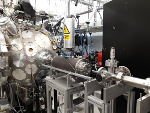LARA CDR Meeting 28th May 2019
Meeting details
Teleconference:
Phone details:
UK: 08082 380274 Austria: 0800 006612 PIN: 5904750902
Full list of telephone contacts may be found here.
Agenda:
- Introduction: KL
- Notes on last meeting and actions arising: All
- Last meeting 30Apr19. Few attendees. No notes posted.
- Conference contributions 2019:
- STFC opportunity call: All
- AoB
Notes:
Present: OE, AK, KL, JPa, CH
Apologies:
- Introduction: KL
- The outline proposal to the EPSRC Transformative Healthcare Technologies for 2050 was submitted. A Doodle for a meeting next week to begin work on the preparation of the full proposal has been created. Meeting date/time will be finalised soon.
- This meeting is targeted at reviewing the status of conference presentations on LhARA and discussing a proposal to STFC against the present "2019 Opportunities" call.
- Notes on last meeting and actions arising: All
- Last meeting 30Apr19. Few attendees. No notes posted.
- Conference contributions 2019:
- IPAC: CH, JPa
- Believed to have been reasonably well received. Other laser-driven proposals (China and Eli) were also presented. FLASH therapy using electron beams were discussed as well as some cyclotron-based proton/ion machines.
- JPa will upload poster and paper to the CCAP wiki.
- GSI: KL
- Similar reception to the IPAC poster. Presentation was in a session where two other laser-driven beam-lines for radiobiology were described. Capture, transport, and focusing of the other proposals were performed using quadrupoles. Our capture efficiency therefore greater on paper. Alternatives have benefit that they are producing beam.
- Focus of meeting was the launch of the Biophysics Collaboration. De facto we've become members. Goal is to organise to help raise resources. We should be able to contribute with the detector/instrumentation and beam-line technologies. Two spokespeople were appointed: Vincenzo Pattera and Yolanda Prezado.
- PTCOG: AK
- Draft poster circulated. Comments welcomed, but soon, as the deadline approaches.
- IPAC: CH, JPa
- STFC opportunity call: All
- Call page on STFC WWW site.
- CCAP proposal preparation page
- We agreed to prepare a proposal for submission against this call. The new Biophysics collaboration and our ambition to position the UK to be leading played in this area will form the context. We agreed to focus on the development of LhARA within this context.
- AoB
- KL: With the progress made in the design of LhARA that is presented in the various conference proceedings, it is time to pick up work on the CDR. This will be a subject for the summer.
- JPa: has been working on the GPT files for the space-charge simulation. Issue that is being addressed is the spacing between the target and the first Gabor lens. We discussed the validity of the input distributions. OE agreed to validate the input files and the extrapolations that JPa is doing. JPo's input is needed to refine the target/Gabor-lens spacing.
- AK: Has begun simulation of the beam-line using GPT. Some issues related to the beam divergence at source. Work continues.
- JPa: Requests check on extrapolation from 8MeV to 15MeV for protons and a discussion of starting assumptions for carbon beams.
Summary of actions
- JPa, CH: Post IPAC paper and posted on the WWW.
- JPa, OE: Make a pass to check i/p distributions for protons.
Notes from IPAC19
by Christopher Hunt
Due to clashes, issues with the papers etc, I didn't manage to attend a lot in person, however these are some observations from what was available and a few conversation.
Found two of the biggest players, ELI and CLAPA (its likely that I missed some of the other big names). Both have similar ideas: laser-target produced protons with some conventional magnet based capture and delivery system, both targeting radiobiological research.
ELI:
- Prague institute
- Expect first beams by the end of the year
- They have designs for a cryogenic H2 target, basically extruding liquid hydrogen into the target area. It wasn't obvious how advanced the designs were
- Conventional focussing
- Use a reasonably big laser with plans to upgrade in the next few years (>1 Petawatt)
CLAPA:
- Peking University
- Publicized results already,
- Very large laser (I think Petawatt class), with planned upgrades
- Uses conventional focussing, maybe quadrupole capture,
- Claim very high stability and high energy beams
- Really seem like they are ahead in the game
Observed some comments on polarised beams to improve performance of laser-target interactions - not sure what the logic is?
General consensus is to just use a bigger laser and conventional capture/focussing. I got the impression that shop-bought petawatt-class laser was the starting point for several groups.
There were no mentions of high-current proton cyclotrons that I could find
